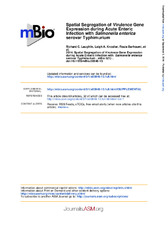| dc.creator | Laughlin, Richard C. | |
| dc.creator | Knodler, Leigh A. | |
| dc.creator | Barhoumi, Roula | |
| dc.creator | Payne, H. Ross | |
| dc.creator | Wu, Jing | |
| dc.creator | Gomez, Gabriel | |
| dc.creator | Pugh, Roberta | |
| dc.creator | Lawhon, Sara D. | |
| dc.creator | Bäumler, Andreas J. | |
| dc.creator | Steele-Mortimer, Olivia | |
| dc.creator | Adams, L. Garry | |
| dc.date.accessioned | 2014-09-02T23:41:23Z | |
| dc.date.available | 2014-09-02T23:41:23Z | |
| dc.date.issued | 2014-02-04 | |
| dc.identifier.citation | Laughlin RC, Knodler LA, Barhoumi R, Payne HR, Wu J, Gomez G, Pugh R, Lawhon SD, Bäumler AJ, Steele-Mortimer O, Adams LG. 2014. Spatial segregation of virulence gene expression during acute enteric infection with Salmonella enterica serovar Typhimurium. mBio 5(1):e00946-13. doi:10.1128/mBio.00946-13. | en |
| dc.identifier.other | http://dx.doi.org/10.1128/mBio.00946-13 | |
| dc.identifier.uri | https://hdl.handle.net/1969.1/152153 | |
| dc.description.abstract | To establish a replicative niche during its infectious cycle between the intestinal lumen and tissue, the enteric pathogen Salmonella enterica serovar Typhimurium requires numerous virulence genes, including genes for two type III secretion systems (T3SS) and their cognate effectors. To better understand the host-pathogen relationship, including early infection dynamics and induction kinetics of the bacterial virulence program in the context of a natural host, we monitored the subcellular localization and temporal expression of T3SS-1 and T3SS-2 using fluorescent single-cell reporters in a bovine, ligated ileal loop model of infection. We observed that the majority of bacteria at 2 h postinfection are flagellated, express T3SS-1 but not T3SS-2, and are associated with the epithelium or with extruding enterocytes. In epithelial cells, S. Typhimurium cells were surrounded by intact vacuolar membranes or present within membrane-compromised vacuoles that typically contained numerous vesicular structures. By 8 h postinfection, T3SS-2-expressing bacteria were detected in the lamina propria and in the underlying mucosa, while T3SS-1-expressing bacteria were in the lumen. Our work identifies for the first time the temporal and spatial regulation of T3SS-1 and -2 expression during an enteric infection in a natural host and provides further support for the concept of cytosolic S. Typhimurium in extruding epithelium as a mechanism for reseeding the lumen. | en |
| dc.description.sponsorship | The open access fee for this work was funded through the Texas A&M University Open Access to Knowledge (OAK) Fund. | en |
| dc.language.iso | en_US | |
| dc.publisher | American Society for Microbiology | |
| dc.rights | Attribution-NonCommercial-ShareAlike 3.0 United States | en |
| dc.rights.uri | http://creativecommons.org/licenses/by-nc-sa/3.0/us/ | |
| dc.title | Spatial Segregation of Virulence Gene Expression during Acute Enteric Infection with Salmonella enterica serovar Typhimurium | en |
| dc.type | Article | en |
| local.department | Veterinary Pathobiology | en |
| dc.rights.requestable | false | en |



